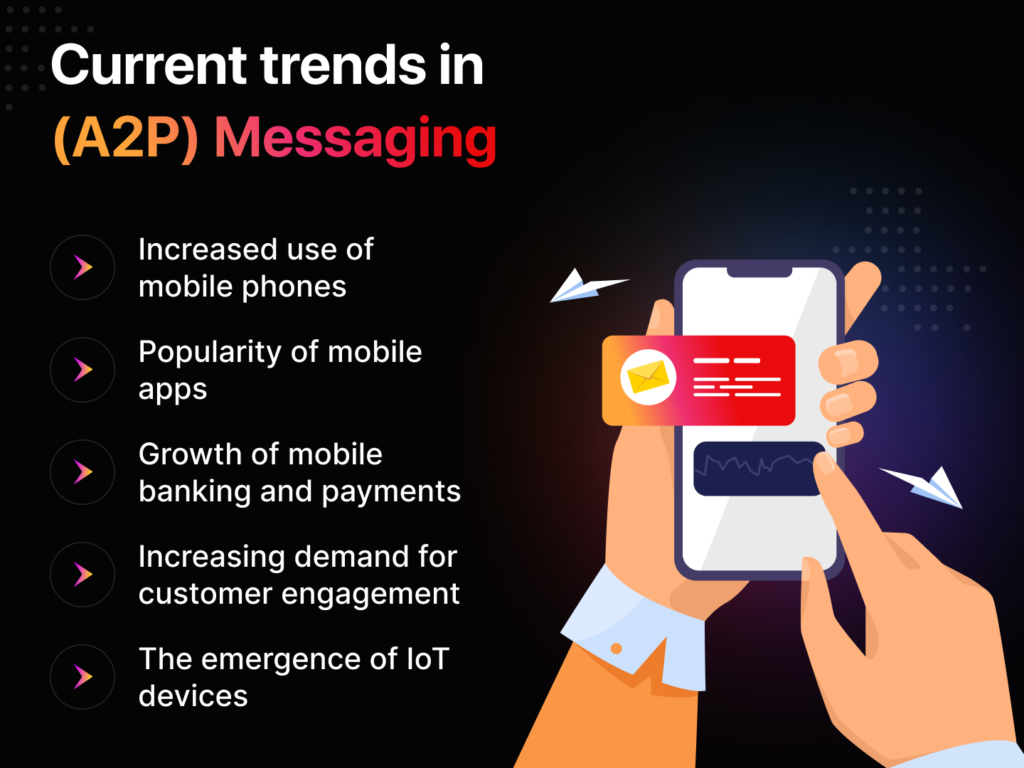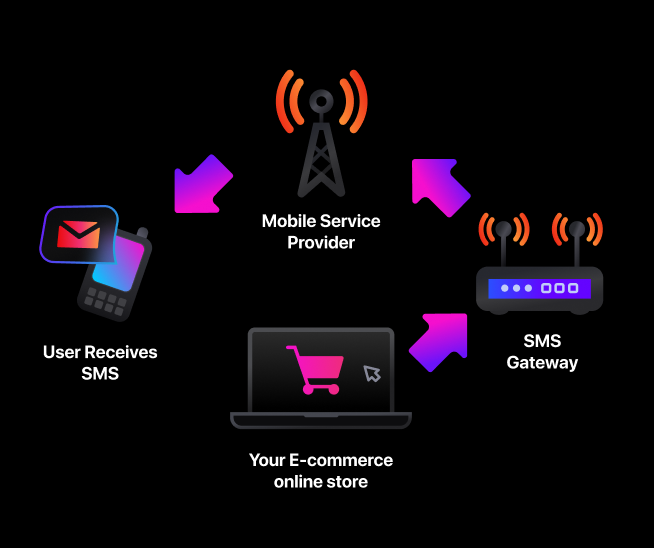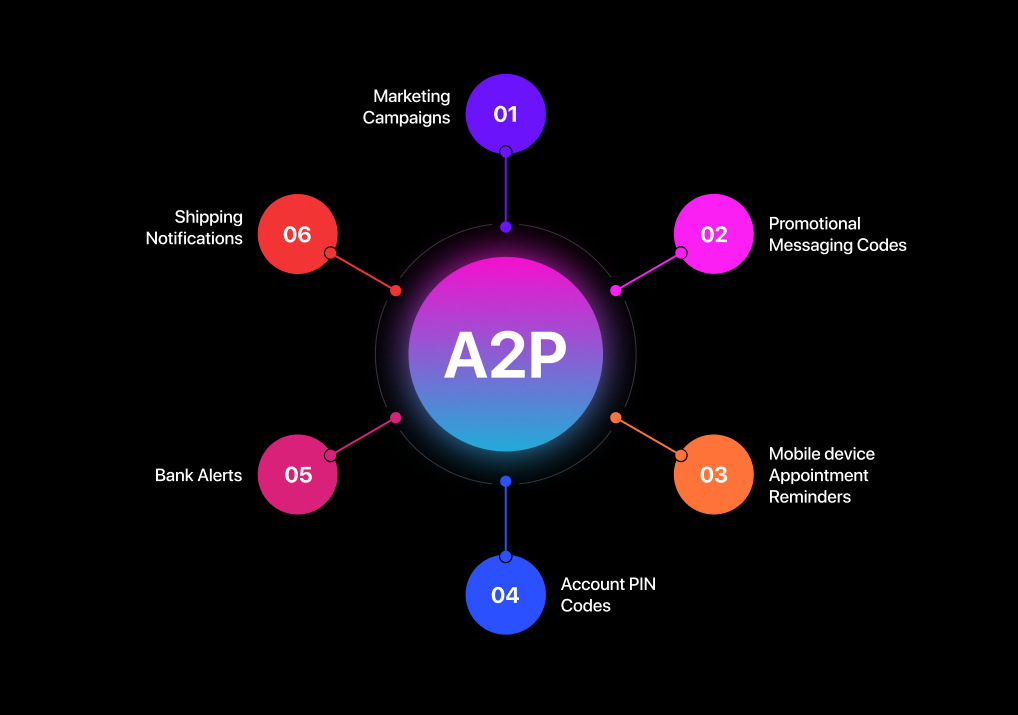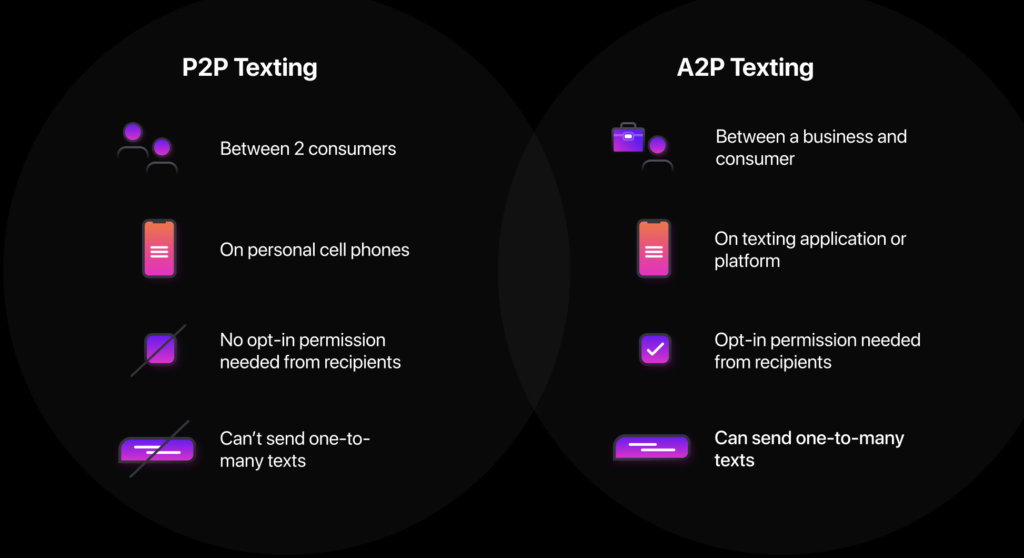What are the best Twilio alternatives, you might be wondering?!
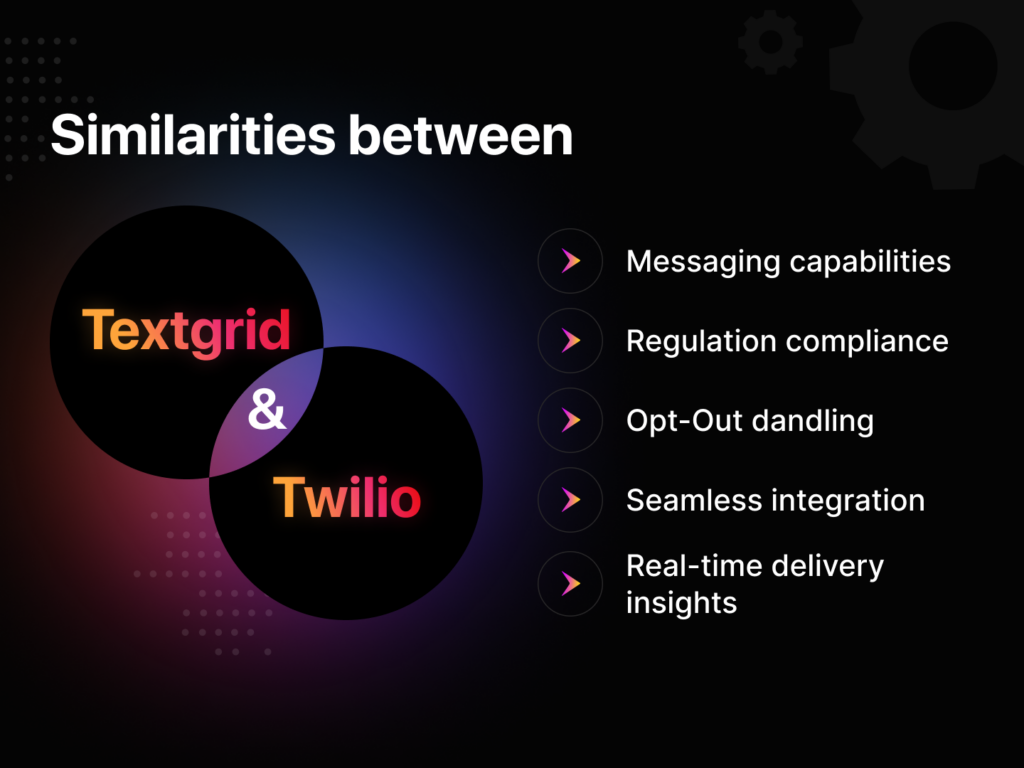
Well, you’re not alone.
Stick with us to discover the pros and cons of each of Twilio’s top competitors and understand how Twilio fares against the competition.
What is Twilio?
Twilio is an esteemed customer engagement platform, enabling businesses to construct distinctive and personalized experiences for their valued customers.
Trusted by thousands of companies and boasting an impressive network of over ten million developers worldwide, Twilio has established itself as a highly renowned and reliable solution.
Consider Twilio as your esteemed collaborator in democratizing communication channels, encompassing voice, text, chat, video, and email, all through convenient APIs.
By leveraging Twilio’s capabilities, your organization gains the ability to effortlessly forge meaningful interactions with customers across their preferred communication channels.
Twilio diligently crafts and enhances a comprehensive suite of tools that enable seamless digital engagement throughout the customer journey, encompassing pivotal stages such as marketing, sales, and customer service.
Furthermore, Twilio has partnered with the world’s leading customer data platform – Segment.
This collaboration empowers you to capture real-time customer data and conveniently analyze it within a unified platform, augmenting your interactions on a grand scale.
Respected organizations such as Dell, Airbnb, and the American Red Cross, among many others, have successfully implemented Twilio’s exceptional tools to their advantage.
Twilio Alternatives: Pricing, Features, Pros, and Cons
- The truth is, nothing is ever perfect, so many users find Twilio expensive, mainly when dealing with high-volume communication requirements.
- Additionally, Twilio has limitations in providing adequate support to meet user expectations.
- Its navigation can be complex, and it often encounters disruptions affecting message and call delivery.
- Still, you don’t need to hesitate to switch since most of these alternatives offer the same (and even far more great features) for half of Twilio’s price range.
So, if Twilio does not meet your requirements, let us present our selection of companies similar to Twilio.
We also made a throughout comparison between them on what you can expect if you decide to switch.
TextGrid vs Twilio
Let’s start wit TextGrid as one of the Twilio alternatives.
Notably, TextGrid offers a bulk purchasing option that enables customers to secure prices 50% lower than Twilio’s.
The bulk purchasing option allows you to take advantage of prices that are 50% less than Twilio’s, passing on the savings to you while accepting lower profit margins.
Most importantly, you won’t face any disruption as it promises a seamless transition process, which only requires a single line of code modification.
TextGrid vs Twilio – Feature Comparison
Differences
- Message Length:
Unlike Twilio, where there is a character limit, TextGrid allows sending long messages without the traditional 160-character limitation. - Queuing and Delivery Prioritization:
TextGrid incorporates structured queuing and prioritizes message delivery based on predefined rules, whereas Twilio provides optimized deliverability through rerouting global traffic every 75 seconds. - HIPAA Compliance:
TextGrid states that it stores data in a HIPAA-compliant environment through Microsoft Azure, catering to customers with specific privacy and security requirements, which isn’t available at Twilio. - Versatile Applications:
TextGrid highlights specific applications such as two-factor authentication, automated alerts, SMS marketing, surveys, autoresponders, and appointment reminders.Twilio only mentions supporting popular channels like SMS, WhatsApp, and MMS. - Automated Default Message Body Purging:
TextGrid allows businesses to set campaigns to automatically purge outdated or obsolete message content, which isn’t available on Twilio. - Character Set Support:
TextGrid specifically mentions comprehensive support for various character sets, enabling effective communication with customers from diverse linguistic backgrounds, whereas a lot of Twilio users report unsatisfactory customer set support. - Number Pooling:
TextGrid offers a number pooling feature that allows businesses to pool phone numbers together for more efficient conversations, while Twilio does not mention a similar feature.
Similarities
- Messaging Capabilities:
TextGrid and Twilio offer similar messaging options that allow businesses to communicate seamlessly with their customers via SMS and other channels. - Global Reach:
Both platforms cater to global senders, supporting messaging across multiple countries. - Compliance:
TextGrid and Twilio prioritize compliance with carrier regulations and provide features for secure and guaranteed message delivery while minimizing the risk of blocked or delayed messages. - Opt-Out Handling:
Both platforms offer features to manage customer opt-outs efficiently, ensuring compliance with regulations and improving customer satisfaction. - Seamless Integration:
TextGrid and Twilio emphasize seamless integration with existing systems and provide easy migration options, allowing businesses to switch platforms with minimal disruption. - Real-Time Delivery Insights:
TextGrid and Twilio provide real-time delivery insights, allowing businesses to monitor and troubleshoot message delivery and engagement.
TextGrid vs Twilio – Pricing Comparison
Textgrid Pricing
Outgoing
Incoming
$0.0035/msg
Free
$0.01/msg
$0.01/msg
$0.0064/min
$0.004/min
Twilio Pricing
Outgoing
Incoming
$0.0075/msg
$0.0075/msg
$0.02/msg
$0.01/msg
$0.013/min
$0.0085/msg
Textgrid
Pricing
Outgoing
Incoming
SMS API
$0.0035
/msg
Free
MMS API
$0.01
/msg
$0.01
/msg
Voice API
$0.0064
/min
$0.004
/min
Twilio Pricing
Outgoing
Incoming
SMS API
$0.0075
/msg
$0.0075
/msg
MMS API
$0.02
/msg
$0.01
/msg
Voice API
$0.013
/min
$0.0085
/min
Carrier Lookup Pricing
Phone Numbers
Email API
$3/mo
$0.1/month/phone number
$0.00063/email $32/mo.
Flat rate. No minimums. No overages
$.008/lookup
$16/mo
$1/month/phone number
$0.000399/email
$19.95/mo + taxes and overages
Textgrid Pricing
Carrier Lookup Pricing
$3/mo
Phone Numbers
$0.1/month/ phone number
Email API
$0.00063/email $32/mo.
Flat rate. No minimums. No overages
Twilio Pricing
Carrier Lookup Pricing
$.008/lookup
$16/mo
Phone Numbers
$1/month/phone number
Email API
$0.000399/email
$19.95/mo + taxes and overages
Plivo vs Twilio
Plivo is another reputable player in the market that provides similar services and competes with renowned companies like Twilio.
Everyone that is looking for an alternative to Twilio sms should definitely consider Plivo’s business features.
Both platforms provide messaging and SMS APIs with support like software development kits (SDKs), no-code flow builders, and integrated routing capabilities.
Both platforms provide messaging and SMS APIs with support like software development kits (SDKs), no-code flow builders, and integrated routing capabilities.
Plivo vs Twilio – Feature Comparison
Differences
- Flow Builders:
Plivo has Plivo High-Level Objects, while Twilio offers Twilio Studio. Both are drag-and-drop editors, but Twilio Studio offers more advanced widgets and trigger capabilities. - Analytics and Reporting:
Plivo boasts SMS and MMS logs in their console, while Twilio offers Messaging Insights, a real-time dashboard with comprehensive reports. - Message Personalization and Flexibility:
Plivo supports GSM and Unicode character formats, while Twilio’s APIs offer additional features like scheduling, Conversations API, and rich content. - Data Compliance and Privacy:
Plivo complies with international regulatory standards, including HIPAA, PCI DSS, SOC2, GDPR, and CPA, while Twilio provides message redaction and advanced opt-out and opt-in customization. - Developer Support Tools:
Plivo comes with API documentation, including sample codes and server-side SDKs. Twilio provides API docs, code snippets, tutorials, and web/mobile SDKs. - Developer Libraries and Resources:
Twilio has a larger community and offers developers a wider range of libraries and resources due to its popularity and broader adoption.Both platforms have comprehensive guides to help developers implement their services.
Similarities
- Voice and Video APIs:
Both platforms offer APIs for building and managing voice and video communication systems. - Deliverability, Routing, and Scalability Features:
Both platforms offer features for message routing, delivery, and scalability, through their networks of carriers. - Data Compliance:
Both Plivo and Twilio comply with international regulations to protect user privacy. - CPaaS Providers:
Both Plivo and Twilio are Communication Platforms as Service providers.
Plivo vs Twilio – Pricing Comparison
Local numbers
Toll-free numbers
Set up (one-time)
Vanity shortcode
Regular shortcode
Outbound SMS- Local numbers
Inbound SMS – Local numbers
Outbound & Inbound SMS – Toll-free numbers
Outbound SMS – Shortcode
Inbound SMS – Shortcode
Outbound SMS – Local
Carrier passthrough fees
Total estimated campaign cost
Outbound MMS – Local
Inbound MMS – Local
Outbound & Inbound MMS – Toll-free
Outbound – MMS
Carrier passthrough fees
Total estimated campaign cost
Plivo Pricing
$0.80/month
$1/month
$1500
$1,000/month**
$500/month**
$0.0050/message
Free
$0.0058/message
$0.0045/message
$0.0050/message
$4,500
$2,835
$7,335
$0.016/message
$0.0080/message
$0.0320/message
$16,000
$8,550
$24,550
Twilio Pricing
$1/month
$2/month
$500
$1,500/month**
$1,000/month**
$0.0075/message
$0.0075/message
$0.0075/message
$0.0075/message
$0.0075/message
$7,500
$2,835
$10,335
$0.020/message
$0.0100/message
Not supported
$20,000
$8,550
$28,550
Plivo Pricing
Local numbers
$0.80/month
Toll-free numbers
$1/month
Set up (one-time)
$1500
Vanity shortcode
$1,000/month**
Regular shortcode
$500/month**
Outbound SMS- Local numbers
$0.0050/message
Inbound SMS – Local numbers
Free
Outbound & Inbound SMS – Toll-free numbers
$0.0058/message
Outbound SMS – Shortcode
$0.0045/message
Inbound SMS – Shortcode
$0.0050/message
Outbound SMS – Local
$4,500
Carrier passthrough fees
$2,835
Total estimated campaign cost
$7,335
Outbound MMS – Local
$0.016/message
Inbound MMS – Local
$0.0080/message
Outbound & Inbound MMS – Toll-free
$0.0320/message
Outbound – MMS
$16,000
Carrier passthrough fees
$8,550
Total estimated campaign cost
$24,550
Twilio Pricing
Local numbers
$1/month
Toll-free numbers
$2/month
Set up (one-time)
$500
Vanity shortcode
$1,500/month**
Regular shortcode
$1,000/month**
Outbound SMS- Local numbers
$0.0075/message
Inbound SMS – Local numbers
$0.0075/message
Outbound & Inbound SMS – Toll-free numbers
$0.0075/message
Outbound SMS – Shortcode
$0.0075/message
Inbound SMS – Shortcode
$0.0075/message
Outbound SMS – Local
$7,500
Carrier passthrough fees
$2,835
Total estimated campaign cost
$10,335
Outbound MMS – Local
$0.020/message
Inbound MMS – Local
$0.0100/message
Outbound & Inbound MMS – Toll-free
Not supported
Outbound – MMS
$20,000
Carrier passthrough fees
$8,550
Total estimated campaign cost
$28,550
Bandwidth vs Twilio
When choosing between Twilio and Bandwidth, it’s a must to consider your specific needs.
Twilio can be a wise choice for a long-term investment since it offers a wider range of services and benefits from network effects due to the expected growth in the CPaaS industry.
On the other hand, Bandwidth is mostly focused on providing customers with voice calling, call tracking, text messaging, and 911 connectivity.
They have scalable APIs and a nationwide IP voice network. Let’s look at the advantages and differences between these two.
Bandwidth vs Twilio – Feature Comparison
Differences
- Network Infrastructure:
Bandwidth has its own nationwide all-IP voice network in the USA, leveraging to ensure high-quality voice fidelity and real-time reliability.
Twilio doesn’t have its network infrastructure and relies on carrier partnerships to provide voice and messaging services. - Reliability and SLA:
Twilio emphasizes its ability to detect outages and reroute traffic, resulting in better reliability and service level agreements (SLAs).
Bandwidth mentioned it’s historical uptime; however, it looks like they don’t have a default SLA. - Sign-up Process:
The sign-up process for Bandwidth is more manual and less automated than Twilio, which may raise concerns about execution and customer experience. - Emergency Services Connectivity:
Bandwidth offers specialized call connectivity to emergency services through its 9-1-1 access API, including automated instant number provisioning, nationwide 9-1-1 call routing, MSAG address validation, and dynamic location routing technology.
Twilio doesn’t have such update yet.
Similarities
- Communication APIs:
Well known for their communication APIs used for integrating voice calling, text messaging, and other communication features into their software and applications. - Voice Calling:
Both platforms offer APIs for voice calling, including access to local and toll-free numbers, call routing, recording, call control, transcription, and other related features. - Dashboard and Reporting:
Both platforms come with web-based dashboards with an interface for managing and monitoring the associated API services, including features like number search and management, reporting tools for tracking usage data, and other administrative functions. - Additional Resources and Support:
Both platforms focus on developer communities, offering extensive resources like tutorials and developer support.
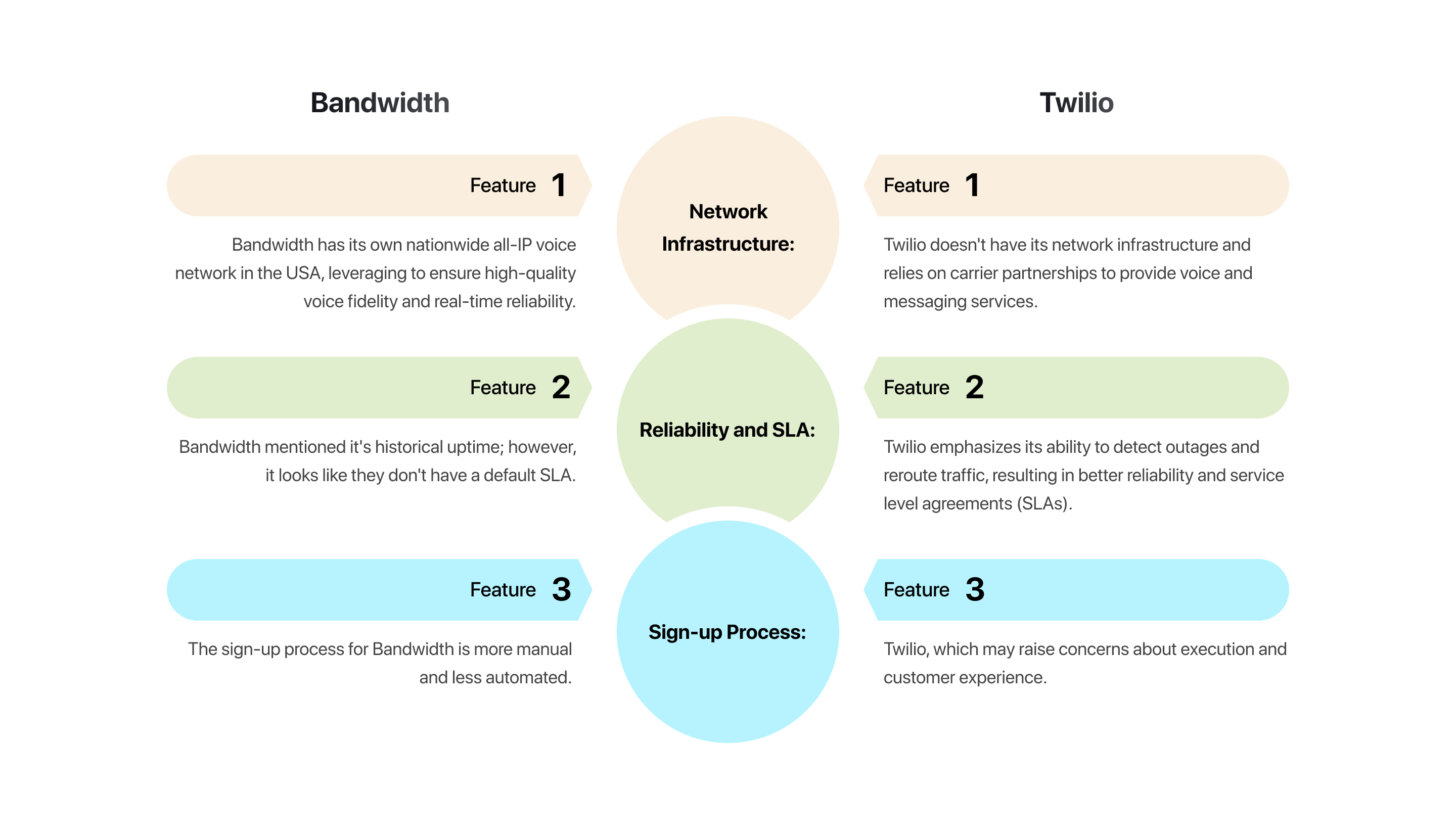
Bandwidth vs Twilio – Pricing Comparison
Voice (In)
Voice (Out)
SMS
Call Recording
Bandwidth Pricing
$0.0055
$0.01
$0.004-0.0075
$0.002
Twilio Pricing
$0.0085
$0.013
$0.0075
$0.0025
Bandwidth Pricing
Voice (In)
$0.0055
Voice (Out)
$0.01
SMS
$0.004-0.0075
Call Recording
$0.002
Twilio Pricing
Voice (In)
$0.0085
Voice (Out)
$0.013
SMS
$0.0075
Call Recording
$0.0025
Telnyx vs Twilio
Telnyx has emerged as a strong competitor to Twilio, offering similar prices and comparable tools for developers.
However, Telnyx has the edge over Twilio regarding global phone numbers that can be accessed through APIs.
Providing local numbers in over 140 countries, Telnyx makes it easier to connect with people worldwide.
Additionally, Telnyx’s PSTN replacement services are available in more than 30 countries, which leads to being a far more convenient option for Twilio.
Telnyx vs Twilio – Feature Comparison
Differences
- Network Infrastructure:
Telnyx uses a private global IP network designed for real-time voice and data communications; on the other hand, Twilio relies on the public internet, which often results in higher latency, packet loss, and security issues. - Carrier Status:
Telnyx is a licensed carrier in 30+ countries, ensuring regulatory compliance and access to local telephony assets.
Twilio is not a licensed carrier, so there are certain restrictions on the number access and operations. - Direct troubleshooting:
Since Telnyx has its network, it can successfully solve routing and call failure issues quickly.
Twilio doesn’t have network ownership, so it has to work with multiple third-party carriers, leading to a slower resolution time. - Cloud Coverage:
Telnyx has a multi-cloud network, being present almost anywhere globally, leveraging AWS, Google Cloud, and Azure for redundancy.
Twilio relies exclusively on one cloud provider, increasing network failure risk. - Number Inventory:
Telnyx has a deep number inventory as a licensed carrier, while Twilio relies on middlemen for number supply, resulting in higher markups and less flexibility.
Similarities
- Communication APIs and Services:
Telnyx and Twilio offer Elastic SIP Trunking, Programmable Voice, and Messaging APIs. Also, both provide voice and messaging services, allowing developers to build communication capabilities into their applications. - Programmable Voice Capabilities and Features:
Both offer global audio conferencing, media streaming, and speech-to-text transcription, text-to-speech, smart IVR, and answering machine detection as part of their programmable voice solutions. - Programmable Voice Capabilities:
Both Telnyx and Twilio support global audio conferencing, media streaming, speech-to-text transcription, text-to-speech, smart IVR, and answering machine detection in their programmable voice solutions. - Number Porting Services:
They offer number porting services, although Telnyx’s porting process is faster and more automated than Twilio’s.
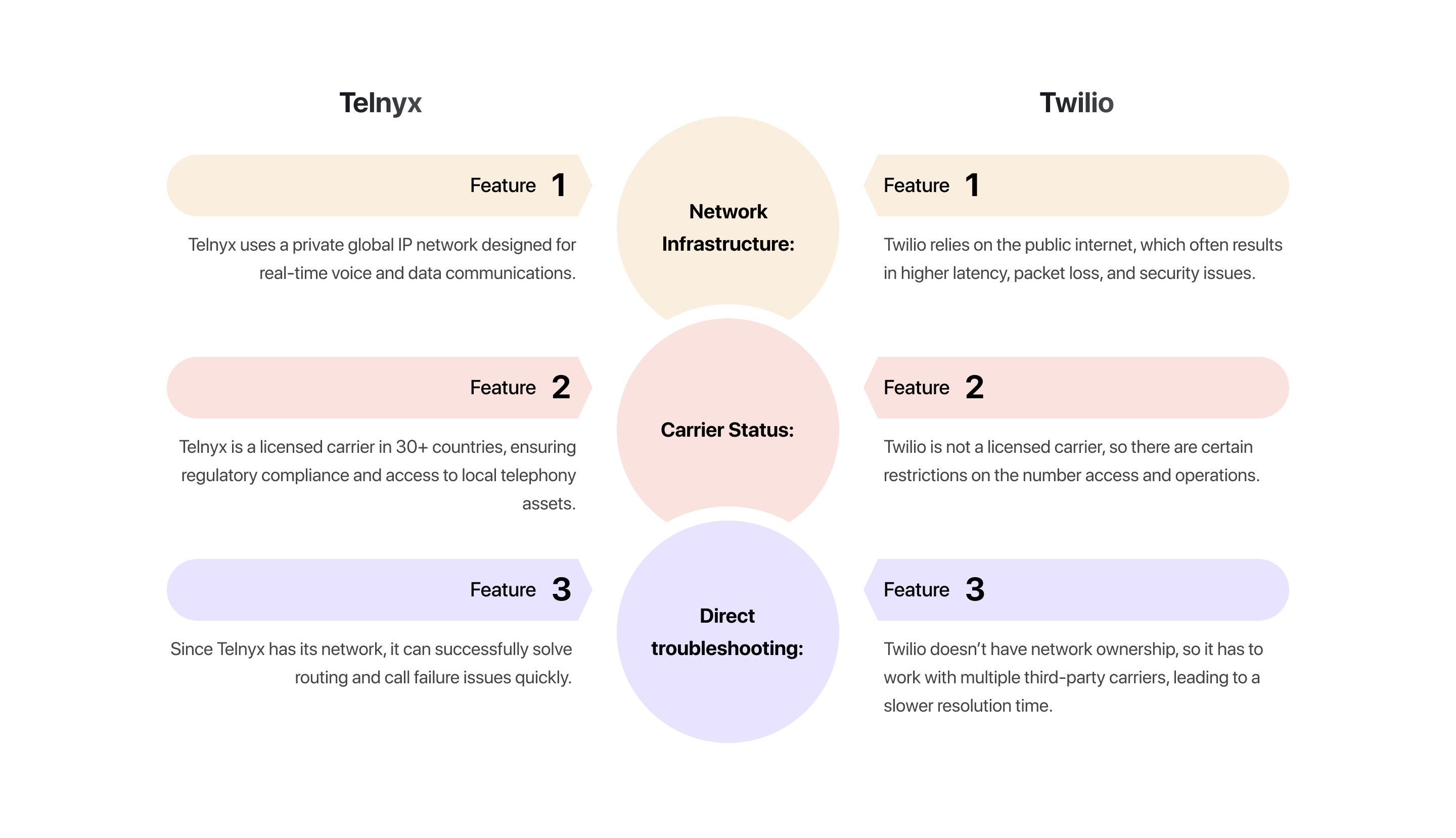
Telnyx vs Twilio – Pricing Comparison
Messaging
Voice (SIP Trunking)
Voice (SIP Trunking)
Numbers
Number Lookup API
Verify API (2FA)
Telnyx Pricing
Starting at $0.004 per message
Starting at $0.005/min
Starting at $0.0035/ min
Starting at $1.00/number
Starting at $0.003/ query
Starting at $0.03/verification
Twilio Pricing
Starting at $0.0075/message
Starting at $0.0053/min
Starting at $0.0034/min
Starting at $1.15 per local
number and $2.15/toll-free
number
Starting at $0.008/query
Starting at $0.05/verification
Telnyx Pricing
Messaging
Starting at $0.004 per message
Voice (SIP Trunking)
Starting at $0.005/min
Voice (SIP Trunking)
Starting at $0.0035/ min
Numbers
Starting at $1.00/number
Number Lookup API
Starting at $0.003/ query
Verify API (2FA)
Starting at $0.03/verification
Twilio Pricing
Messaging
Starting at $0.0075/message
Voice (SIP Trunking)
Starting at $0.0053/min
Voice (SIP Trunking)
Starting at $0.0034/min
Numbers
Starting at $1.15 per local
number and $2.15/toll-free
number
Number Lookup API
Starting at $0.008/query
Verify API (2FA)
Starting at $0.05/verification
MessageBird vs. Twilio
Last but not least, we have Messagebird, which is another Twilio like service.
This CPaaS was created in 2013, mainly catering to small and medium-sized companies, aiming to lessen the whole process of businesses effectively communicating with their customers.
The feature array boasts options for sending personalized messages through SMS, MMS, and push notifications for marketing, customer care, or general notifications.
MessageBird also stands out by providing incredibly simplistic customer communication.
It’s almost the same as Twilio as it has almost the same features, including a very simple setup and intuitive interface with all the communication channels in one place.
MessageBird vs Twilio – Feature Comparison
Differences
- Supported Channels:
Unlike Twilio, which mostly focuses on various chat services, SMS, MMS, voice, and video calls; MessageBird supports other popular channels such as Email, WeChat, Instagram, LINE, and Telegram. - Video Scheduling:
MessageBird has implemented a video tool where customers can easily schedule and host video calls for up to 24 hours. Twilio hasn’t developed such type of feature yet. - Support Plans:
MessageBird requires payment for support plans, whereas Twilio’s support availability may largely differ based on the selected pricing tier. - Twilio Programmable Chat:
One of the most famous Twilio features is the Programmable Chat, which simplifies chat and chatbot development with essential features. MessageBird does not have this type of feature yet. - Twilio Programmable Voice API:
Another distinctive feature of Twilio that MessageBird still lacks is the Programmable Voice API. This option allows developers to build and monitor calling systems with various routing options. - Twilio Flex:
Twilio Flex is exclusively developed as a contact center solution that integrates various Twilio services, which isn’t available on MessageBird.
Similarities
- Multi-channel Communication Management:
MessageBird and Twilio have dedicated their platforms to businesses that look for seamless communication and management across standard channels such as SMS, email, chat, and calls. Also, both platforms have implemented WhatsApp, Facebook Messenger, and SMS. - Omnichannel Customer Service Support:
Both platforms have implemented omnichannel customer service support, which helps businesses handle customer interactions seamlessly across different channels. - Data Automation:
Both platforms include features for automating data processes and workflows.
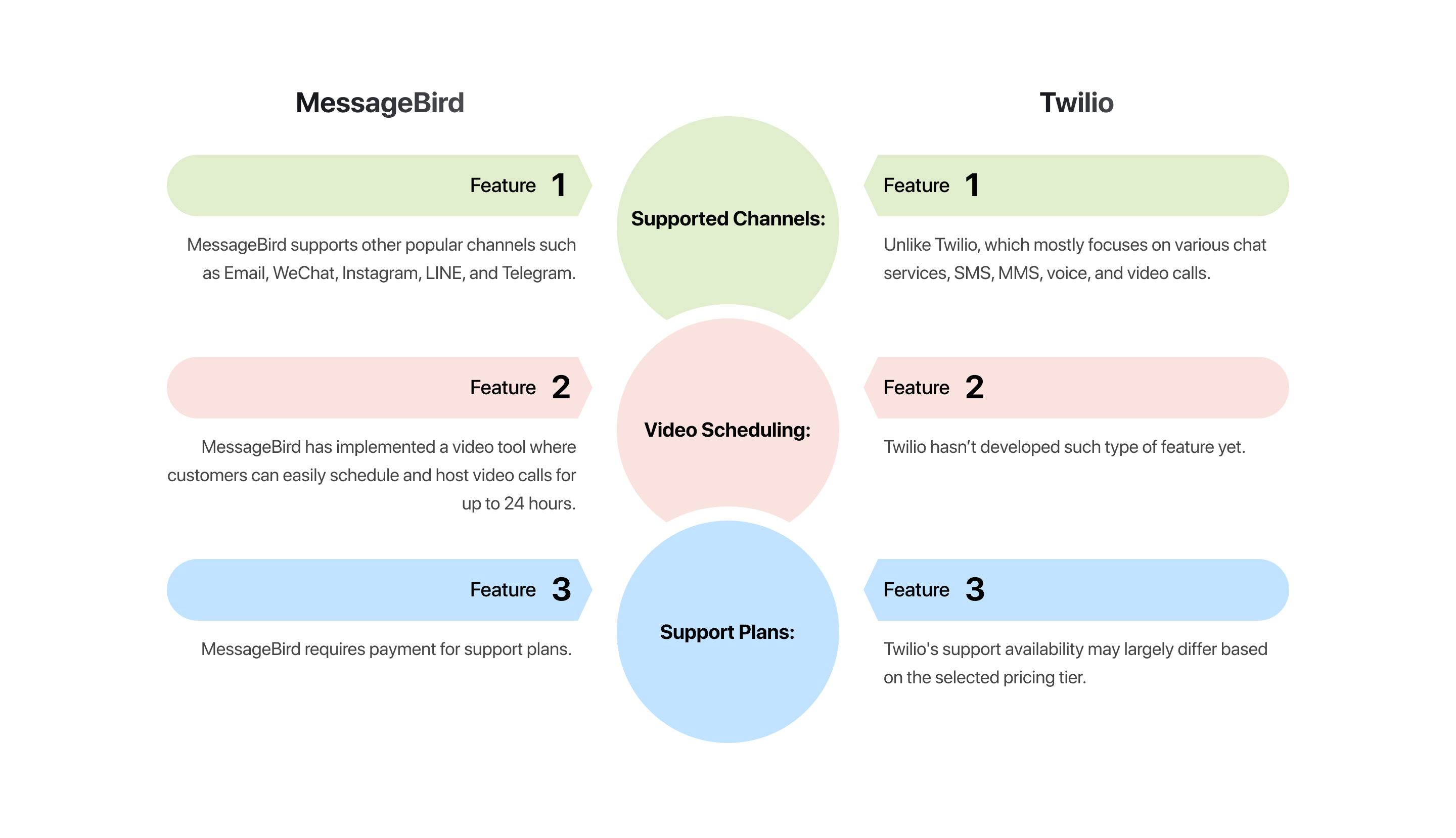
MessageBird vs Twilio – Pricing Comparison
API Pricing – WhatsApp
Voice API
SMS API
Numbers API
Pro Plan
Pro Plus Plan
Start Up Plan
MessageBird Pricing
$0.01 per message
$0.01 per minute
$0.01 per message
$1 per month
$50 per month
$150 per month
Free
Twilio Pricing
$0.0015 per min per participant
$0.0042 per WhatsApp
Template message sent
$0.005 per WhatsApp
session message
$0.007 per min for termination
$0.0075 programmable
messaging
$0.0085 per minute to receive
a call
$0.013 programmable voice
MessageBird Pricing
API Pricing – WhatsApp
$0.01 per message
Voice API
$0.01 per minute
SMS API
$0.01 per message
Numbers API
$1 per month
Pro Plan
$50 per month
Pro Plus Plan
$150 per month
Start Up Plan
Free
Twilio Pricing
API Pricing – WhatsApp
$0.0015 per min per participant
Voice API
$0.0042 per WhatsApp
Template message sent
SMS API
$0.005 per WhatsApp
session message
Numbers API
$0.007 per min for termination
Pro Plan
$0.0075 programmable
messaging
Pro Plus Plan
$0.0085 per minute to receive
a call
Start Up Plan
$0.013 programmable voice
Twilio Competitors: How They Rank
Here we came up with an all-inclusive table guide to assist you in selecting the perfect platform for your requirements.
It will provide a detailed overview of each platform’s strengths so you can easily determine the most suitable API service for your specific needs.
Twilio
TextGrid
Plivo
Bandwidth
Telnyx
Message-Bird
Free Incoming SMS
Two-factor authentication
Analytics and reporting
Multimedia formats
Scalability and Reliability
Message Queueing
Text-to-speech
Answering Machine Detection
Multilingual Support
Password resets
Email receipts
Deliverability insights
Twilio
Free Incoming SMS
Two-factor authentication
Analytics and reporting
Multimedia formats
Scalability and Reliability
Message Queueing
Text-to-speech
Answering Machine Detection
Multilingual Support
Password resets
Email receipts
Deliverability insights
TextGrid
Free Incoming SMS
Two-factor authentication
Analytics and reporting
Multimedia formats
Scalability and Reliability
Message Queueing
Text-to-speech
Answering Machine Detection
Multilingual Support
Password resets
Email receipts
Deliverability insights
Plivo
Free Incoming SMS
Two-factor authentication
Analytics and reporting
Multimedia formats
Scalability and Reliability
Message Queueing
Text-to-speech
Answering Machine Detection
Multilingual Support
Password resets
Email receipts
Deliverability insights
Bandwidth
Free Incoming SMS
Two-factor authentication
Analytics and reporting
Multimedia formats
Scalability and Reliability
Message Queueing
Text-to-speech
Answering Machine Detection
Multilingual Support
Password resets
Email receipts
Deliverability insights
Telnyx
Free Incoming SMS
Two-factor authentication
Analytics and reporting
Multimedia formats
Scalability and Reliability
Message Queueing
Text-to-speech
Answering Machine Detection
Multilingual Support
Password resets
Email receipts
Deliverability insights
Message-Bird
Free Incoming SMS
Two-factor authentication
Analytics and reporting
Multimedia formats
Scalability and Reliability
Message Queueing
Text-to-speech
Answering Machine Detection
Multilingual Support
Password resets
Email receipts
Deliverability insights
- Best SMS, MMS API – The Winner is TextGridAll in all, we can say that if you’re searching for an SMS API with the added advantage of free incoming messages and half the price for outgoing ones, TextGrid is a perfect choice.
- Best Global Coverage – The Winner is PlivioPlivo is renowned for its global coverage in voice services.
- Incorporated Emergency Services – The Winner is BandwidthBandwidth incorporates emergency 911 services for seamless integration.
- Programmable Voice and Messaging Features – The Winner is TelnyxTelnyx’s API specializes in an extensive range of features for programmable voice and messaging, giving you the freedom and flexibility to build customized voice applications, IVRs, call-tracking systems, and more.
- Popular communication channels – The Winner is MessageBirdFinally, if you are searching for popular communication channels like WhatsApp or Facebook Messenger, MessageBird is the way to go, as Twilio only supports standard channels like SMS, MMS, voice calls, and email.


![Twilio Alternatives: The Complete List [2024]](https://textgrid.com/wp-content/uploads/2023/09/Banner_7.png)
![What is A2P Messaging: Everything You Need to Know [2023]](https://textgrid.com/wp-content/uploads/2023/09/Banner_9.png)
